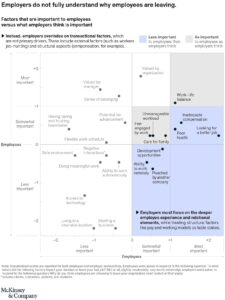 “By not understanding what their employees are running from, and what they might gravitate to, company leaders are putting their very business at risk”
“By not understanding what their employees are running from, and what they might gravitate to, company leaders are putting their very business at risk”
In a recent study conducted by McKinsey, data revealed that there is a disconnect between employees and employers with regard to the cause of attrition.
Employers assigned compensation as the most meaningful factor, among a couple of others (see chart). Compensation is table stakes. You need it to be a relevant and reasonable option, but overall, the impact of more money in an effort to hire or retain someone lasts an average of just 90 days.
Two of the most important factors for employees were largely overlooked and under considered by employers, and those were a sense of belonging and being valued by their manager. In other words, employees ranked these as the most important factors, and employers rated these among the least important.
So let’s talk about belonging…
In another study conducted by think-tank Coqual, employees who felt a high sense of belonging were more engaged with their work, planned to stay at their job for at least two years, and felt very loyal to their company. Those experiencing “low belonging” were four times more likely to say they felt stalled in their careers.
At Lead for Culture, we measure Belonging using the following dimensions of culture:
- Appreciation – Which is applied to a range, not just tangible rewards and recognition, but also feeling seen and respected by colleagues, or feeling as though one has a meaningful presence on their team.
- Connection – Meaningful professional and social interactions with peers and managers; relationships that matter to someone.
- Affinity – When employees feel valued, and when they feel their own sense of purpose and values align with their employer, a deeper bond between employee and employer takes place, it becomes part of someone.
If you are an employer reading this, it all sounds intuitive and makes sense, but you also realize this is a massive lift. This is why culture is a relentless, everyday endeavor. It has to be built into the fabric of everything you do. Everything you say. Everything you offer and design for employees needs to be intentional in an effort to understand and create these feelings and experiences for employees.
These three factors, and belonging on the whole, also have to be managed at multiple levels. The organization itself – the foundation of the company, senior leaders, managers, and peers all have to be included in this elaborate network for which you create and sustain a culture of belonging.
